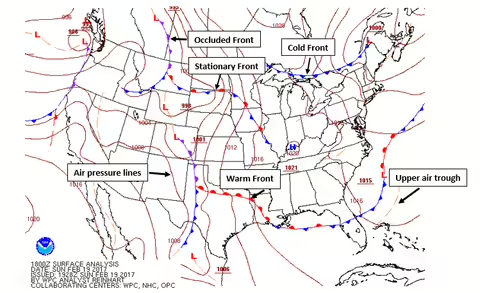Weather Map
Reading a weather map
We watch the news, search the web, or go to the weather app to see what the great outdoors is like at the moment and what it will be for the next few days. You may go ahead and look at the weather map. It typically has many lines, symbols and colors. Any idea what it all means?
H and L
First let’s talk about the H’s and L’s. These are symbols for air pressure, essentially the amount of force exerted by air. H’s stand for higher pressure, L’s for lower pressure.
- At sea level, almost 15 pounds of force is exerted on every square inch of earth’s surface.
- Pressure can vary slightly from place to place.
A general rule is that high pressure means fair weather, while low pressure stands for cloudiness or storms. Another rule is that air will flow from high to low. Winds blow in a clockwise motion away from high pressure and spiral in a counter clockwise fashion into low pressure.
Lines
- The blue lines with triangles are called cold fronts. They represent the leading edge of colder air. The triangles are pointed in the direction the cold air is going.
- Red lines with semi-circles are warm fronts, the leading edge of warmer air. Again, the semi-circles point to where the warm air is going.
- An alternating red and blue line means there is warmer air and colder air next to each other, but neither is moving, hence the name stationary front.
- Rarely discussed, a purple line with both triangles and semi-circles is called an occluded front. Sometimes the cold front catches up to a warm front, lifting the warm air completely off the ground. Main thing to remember about this line is that it means the low pressure it’s associated with is about to die out.
- Fronts are only associated with low pressure. You’ll never see any frontal line coming out of an H.
- The circles or lines with numbers in the low 1000’s are lines of air pressure. The numbers are for millibars of air pressure.
- Dashed lines represent an upper air trough; that area may be having clouds with some precipitation, but typically it’s not too extreme.
- White lines show changes in air pressure. Numbers on these lines are called millibars, a measure of force. The closer the lines are together, the greater the wind.
